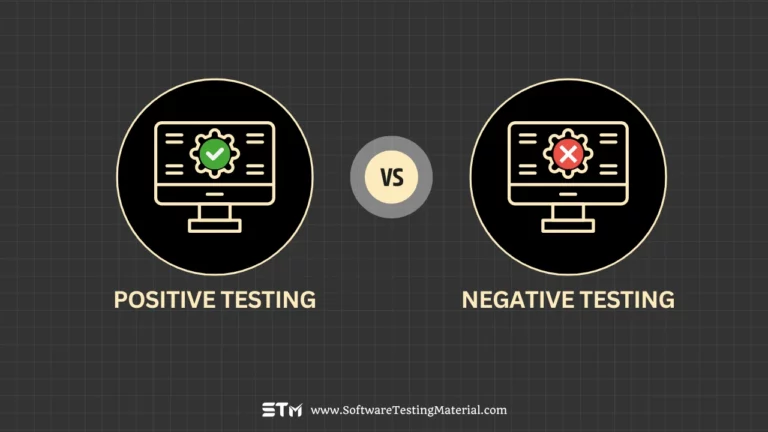Exploratory Testing – Complete Guide
Hope you have heard the term Exploratory testing quite often. Today in this article, we will see what is exploratory testing and when should it be performed and the advantages & disadvantages of it.
In this tutorial, you will learn the following
Let’s get started.
What is Exploratory Testing?
The term ‘Exploratory’ means ‘travel through’ or ‘inquire in to’ or discuss a subject into detail. Exploratory testing in software testing means the same. Where in a tester is exploring the software or going through its functionality. What is important here is testers applying their own experience, knowledge, or thinking about the application with user perception.
Point to be noted here is, it is not a structured way of testing, the user plays with the application, execute functional flow on the basis of his own perspective.
Where it is Applied
This is the most adopted testing in Agile development, as in the Agile methodology testing team gets release very frequently, and with every release, it is expected from a tester to give its feedback quickly.
An experienced tester quickly goes through the release and explore all the areas, note down the functional flaws, and uncover the bugs which are not possible in a traditional approach where tester go through pre-formatted test cases.
An agile team has to work in coordination, with the help of exploratory testing, the testing team become very quick and can save the time of overall development time, if the testing team finds blocker bugs in the first attempt of exploratory testing, they can reject the build in early stage and save the time.
Advantages of Exploratory Testing
- It is a quick and time-saving method of testing, it helps to take real time decisions.
- It helps the tester to understand the application when there is no enough document present.
- It is a more practical approach where a tester thinks with a user perspective.
- It is a human approach testing, which can not be automated where real user intelligence and experience is used, it does not work on a pass or fail, it actually thinks about User-friendliness, ease of use or usability aspect of the application.
- Structure testing can not highlight certain scenarios in advance, whereas Exploratory testing goes up to the deepest level of testing because the tester is simultaneously learning the software and trying to get the defects in the system.
Disadvantages of Exploratory Testing.
- Sometimes it is difficult to reproduce the defect because the testing is unstructured actual steps are missed and can not be written in the bug reproduction steps.
- It should not be done by a fresher or who has no prior experience in the domain because he won’t be able to think with the user perspective and will always log unrealistic bugs which will kill the time of the entire team.
- Automation is not possible like few things are totally dependent on end user’s own perspective, intelligence, or mindset…and these human depended things can not be automated ever.
- Some time it is very difficult to represent the work done by the Testing team because there is nothing written or captured, there is no count of test cases that are executed against any functionality, its hard to estimate testing hours and automation need.
- It does not guarantee Zero or 100 % bug-free release, testing team has to go through the regular testing or structured testing even though a good amount of exploratory testing is done, No one can rely 100% on Exploratory testing.
Skills Required To Perform Exploratory Testing
Exploratory testing should be performed when testers have,
- Ability to think above and beyond, a tester should be able to think above and beyond then whatever is written in the requirement document, then only he will uncover serious and functional flaws of the application.
- Effective time management skills, the tester should be a quick learner and must follow the time lines, he should understand the critical area of applications and give more time to explore that area, for example rather looking and noting down the UI issues he should explore functional aspects within the given time.
- Domain expertise, the tester must have a good understanding of the domain, he should know what he is exploring and what should be the outcome.
- Good analytical and reasoning skills, other than domain knowledge he must be good at analytical and reasoning skills, then only he can communicate the defect to the team and explain the potential risk of the bug.
- Good at communication and be Proactive, the tester should be a good communicator so that he can write or explain the bug in clear and straight forward language, communication is the key of effective testing, which saves time of the entire project and can deliver the software before the timelines with proper listing of known bugs.
A practical example of Exploratory testing
Let’s take an example of exploratory testing,
A Web development company [ecommerce] has to release its last build in one and a half months, it has a team of 3 developers and a tester who is a fresher. No much documents are present only a few user stories are in the system and the team has to complete these user stories on time. The test cycle is about to begin in one day and they have to finish testing in 7 days.
An experienced test engineer gets hired in the team since he has domain experience, he won’t spend much time on document and stories reading, he will directly go to the application and start looking at the core functionalities of the application.
He can adopt the following ways of doing exploratory testing.
- Freestyle or Adhoc Testing: he can randomly click on any link, or button or any operations to see the response of the application, he can note down the bug if application breaks some where.
- Scenario-based testing: based on his experience he can think of multiple scenarios like search a product and add it into the cart and proceed to checkout, he can observe the behavior if he is able to execute each scenario successfully or not.
- User’s roles based testing: he can explore the application by using different user roles of the application, and for every step, he can check if the particular user is allowed to perform certain actions or not.
- Structured Exploratory testing: he can write down high-level test steps, for example, Login, search, add to cart, checkout, and payment. Now he can explore each area in detail. And write down the bugs he discovered while testing.
Also, read these 100+ Types of Software Testing
What is Automated exploratory testing?
Do you have a question like how to perform exploratory testing in an automated way? Of course, it can be automated. While doing exploratory we don’t give much importance to documentation. Doing this testing is to save time. If we spend time on documentation it will kill all of our time and in agile its not possible. By not documenting the steps sometime we may face difficulty in reproducing the steps.
The process of automating the documentation process of exploratory is known as Exploratory Automated Testing. By automating the documentation process we get a better bug reproduction report.
There are a number of tools in the market that help to automate the process of documentation. These tools help you in capturing screenshots, audios, & videos with each test step, monitor log errors, and record them. Check these best Exploratory testing tools in the market.
Conclusion
Exploratory testing is very important and a very practical type of testing which is time saving and represents Tester’s analytical and reasoning skills. It is one of the most used techniques in Agile development where much importance is not given to documentation and faster releases are expected from the team.
But Exploratory has its own limitations, like its success is totally depends on tester’s experience and intelligence. Automation is never possible in Exploratory testing.







